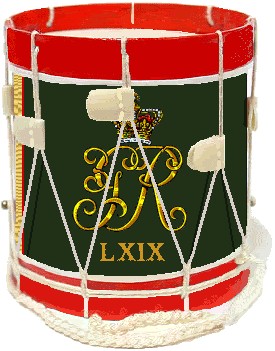LXIXth Regiment of Foot


In the center of each colour is to be painted, or embroidered, in gold
Roman characters, the number of the rank of the regiment, within the
wreath of roses and thistles on the same stalk. The second Colour to be
the colour of the facing of the regiment, with the Union in the upper
canton; except those regiments which are faced with red, white, or black.
The 69th was originally raised as the 2nd Battalion
of the 24th Regiment of Foot on September 20, 1756.
In January of 1758, a number of companies of the 24th Foot's
Second Battalion, were assigned duties as marines on board the
fleet, and sailed with Admiral Edward Boscawen for Halifax and
Louisburg. Orders were issued on April 23, 1758, re-designating
the 2nd Battalion 24th Foot as the 69th Regiment of Foot.
Acting as marines, the companies of the 69th took part
in various actions during the siege of Louisburg in June of 1758.
The 69th sailed home with the fleet, before the winter of 1759.
Albeit speculation, it is logical to assume that the 69th did not receive
new Colours, drums, or change lace until returning to Europe.
In 1761, the 69th Regiment of Foot participated in the attack on
Belleisle, an island off the French coast near Brest. The regiment
participated in amphibious operations against the French island of
Martinique in the West Indies in 1762. After the capture of
Martinique, the 69th Foot sailed for Ireland.
By 1781, the 69th Regiment of Foot was again on board the fleet
to act as Marines. Reportedly, the 69th was 'docked' in New York in
September of 1781. In 1782, the 69th Foot was deployed as marines
in Hood's division of Admiral Rodney's fleet. The 69th distinguished
itself at the Battle of the Saintes, off the Island of Dominica, in the
West Indies on April 12, 1782. The Battle of the Saints ended
the rule of the French fleet in the West Indies.
The 69th Regiment of Foot was granted the county
title of the South Lincolnshire Regiment in 1782.

The front [of the drums] to be painted with the colour of the facing
of the regiment, with the King's cypher and crown, and the
number of the regiment under it.
if you arrived at this page from a search engine click here to load the menu page



